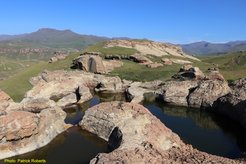Isotope Data Reveal Millennia of Ecological Change in the Mountains of Lesotho, Southern Africa
A new paper in Communications Earth & Environment uses plant wax biomarkers from archaeological sediments to understand human-environment interactions in mountain ecosystems for the past 60,000 years
In the past, studies have used plant and animal remains and geochemical analysis to recreate the environments experienced by upland foragers in western Lesotho over the last 60,000 years. However, poor preservation and difficulties with interpretation have limited the insights gained from these techniques.
In a new publication in Communications Earth & Environment, an international team of scholars led by researchers from the Max Planck Institute of Geoanthropology presents the first ever attempt at using plant wax biomarkers preserved in the sediments at Ha Makotoko, a rock shelter inhabited by hunter-gatherer communities across millennia, to reconstruct vegetation and climate history in the region through time. Their research reveals changes in plant communities and variability in temperature and rainfall, indicating ecological stability at a time when access to water was less predictable in nearby regions.
Because these waxes are able to survive over millennia, researchers were able to show climatic and environmental changes of direct relevance to human societies over the Late Pleistocene and into to the Holocene. Using gas chromatography and mass spectrometry to test the molecular distributions and preservation of organic compounds, the team measured plant wax n-alkane concentrations and analyzed carbon and hydrogen isotopes to look into the ecological and climate settings that hunter-foragers would have adapted to while occupying the rockshelter in the past.

The results demonstrate that climate, specifically precipitation and temperature, remained relatively stable across the Pleistocene and through much of the Holocene in the Phuthiatsana Valley of western Lesotho, where Ha Makotoko is located, with drastic increases in rainfall and warming occurring only in the last 5 thousand years. The data show that it has become much warmer and wetter in the Phuthiatsana in the later part of the Holocene, and that these climate conditions had a major impact on plant wax carbon and hydrogen isotope values. Nevertheless, the valley would have had reliable food and water resources for the people living in the region, specifically during the Pleistocene when nearby areas of southern Africa faced aridity and irregularly distributed resources.
Alongside members of the Max Planck Institute of Geoanthropology and Bryant University, researchers from the University of Oxford, Oxford Brookes University, University of Michigan, University of Toronto, Flinders University, University of Witwatersrand, California State University, Stanislaus, and Max Planck Institute of Biogeochemistry, and community members from Lesotho, collaborated on the study.
